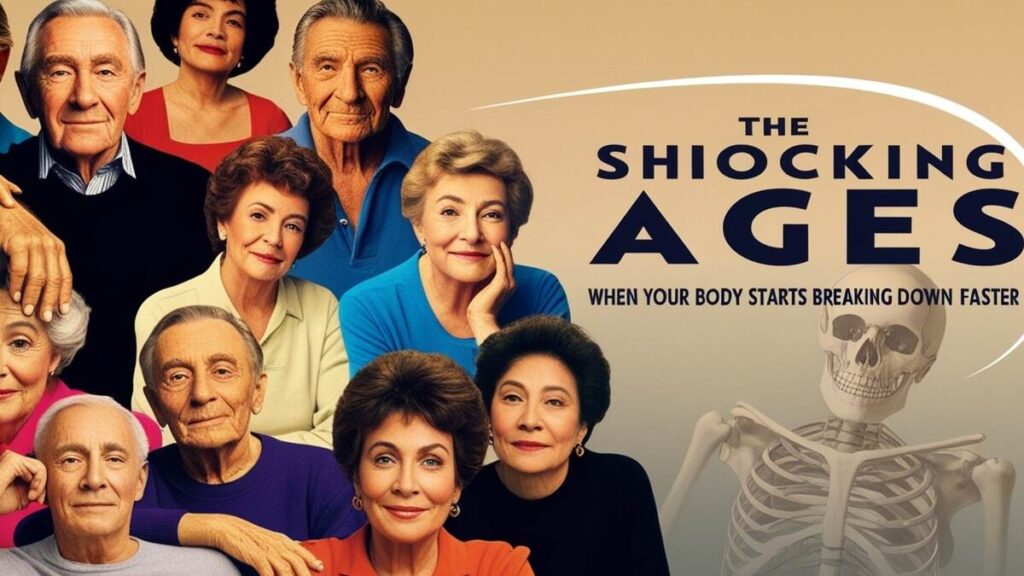Introduction to Aging and Body Breakdown
Aging is a complex process that begins earlier than many expect—usually in your mid-20s—when your body’s ability to repair itself subtly declines and your body starts breaking down. Although these changes are often imperceptible initially, they accumulate over time, driven by daily wear and tear, lifestyle choices, and environmental influences.
- Introduction to Aging and Body Breakdown
- 15 Indications That Your Body Is Aging More Rapidly Than You
- When Do You Start to Feel the Effects of Aging?
- At What Age Does Your Body Start to Hurt?
- Female Aging Body Changes
- The Early Warning Signs in Your 20s
- The Turning Point in Your 30s
- The Accelerated Breakdown in Your 40s
- The Crucial Changes in Your 50s
- The Steeper Decline in Your 60s
- The Golden Years: 70s and Beyond
- Step-by-Step Guide to Slowing Down the Aging Process
- Conclusion
This gradual decline impacts physical and mental health, from slowing metabolism to reduced skin elasticity and muscle recovery. Imagine your body as a high-performance car: pristine when new but requiring consistent upkeep to function efficiently. Without regular maintenance, issues compound, leading to breakdowns. By understanding the stages and signals of aging, you can take proactive steps to counteract its effects, ensuring a healthier and more robust journey through life.
15 Indications That Your Body Is Aging More Rapidly Than You
Do you suspect your body might be aging faster than it should? Here are 15 Indications That Your Body Is Aging More Rapidly Than You, along with tips to address them:
- Chronic Fatigue: Persistent tiredness even after rest.
- Dry, Wrinkled Skin: Early signs of collagen loss.
- Hair Thinning or Loss: A common symptom of aging.
- Frequent Aches and Pains: Stiffness in joints and muscles.
- Memory Issues: Forgetfulness or trouble focusing.
- Weakened Immune System: Getting sick more often.
- Decline in Vision: Difficulty reading or night blindness.
- Hearing Loss: Struggling to hear conversations.
- Slow Recovery: Healing from injuries takes longer.
- Weight Gain: Especially around the abdomen.
- Low Energy Levels: Struggling with daily activities.
- Reduced Flexibility: Difficulty bending or stretching.
- Bone Loss: Fragile bones or fractures.
- Diminished Muscle Strength: Trouble lifting or moving heavy items.
- Digestive Issues: Bloating, constipation, or irregular bowel movements.
Recognizing these signs can help you make lifestyle changes to combat premature aging.
When Do You Start to Feel the Effects of Aging?
If you’ve ever wondered, “When do you start to feel the effects of aging?” the answer largely depends on factors like lifestyle, genetics, and overall health. Subtle signs often begin in your 30s, such as reduced stamina, slower recovery from exercise, and the first hints of joint stiffness. These early changes may go unnoticed if you’re active and healthy. However, by your 40s, aging becomes more apparent.
Common effects include chronic aches, recurring muscle soreness, and a noticeable dip in energy levels. Tasks that once seemed effortless may require more effort. This phase serves as a wake-up call, highlighting the importance of adopting healthier habits to manage these changes and maintain vitality as you age.
At What Age Does Your Body Start to Hurt?
Aging often introduces physical discomfort, leaving many to wonder, “At what age does your body start to hurt?” While this varies by individual, most people notice joint pain and muscle stiffness in their 40s and 50s. This discomfort is often the result of cumulative wear and tear on the body’s joints, leading to reduced cartilage that acts as a cushion between bones. Over time, repetitive movements and physical activity cause minor injuries to tissues, which can lead to chronic inflammation.
This combination results in stiffness, limited mobility, and even arthritis. Factors such as weight, physical activity levels, and diet can either accelerate or delay these effects, making proactive care essential for long-term joint health.
Tips to Reduce Pain:
- Incorporate anti-inflammatory foods like turmeric and omega-3-rich fish into your diet.
- Engage in low-impact exercises like swimming or yoga to maintain joint mobility.
- Stay hydrated to improve joint lubrication.
Female Aging Body Changes
Women experience unique challenges as they age, often tied to hormonal shifts. Female aging body changes can begin as early as the 30s but become more apparent during menopause.
Hormonal Shifts in Women
- Skin thinning and a decrease in bone density are caused by declining estrogen levels.
- Menopause often triggers hot flashes, mood swings, and sleep disturbances.
Physical and Emotional Impacts
- Weight gain, especially around the abdomen, becomes ordinary.
- Emotional challenges, such as anxiety or depression, may increase.
Women can navigate aging more smoothly by addressing these changes with targeted lifestyle adjustments.
The Early Warning Signs in Your 20s
While the 20s are often considered the pinnacle of youth and vitality, subtle changes in your body have already begun to take root. Collagen production decreases by around 1% annually after age 25, leading to the first signs of skin aging. Similarly, your metabolism slows gradually, increasing the risk of weight gain.
Key Changes:
- Reduced skin elasticity and the appearance of fine lines
- Gradual decline in bone density
- Slower muscle recovery after intense physical activity
Ignoring these signs can set the stage for more significant problems later in life. Adopting a healthy lifestyle during this decade is essential to delaying when your body starts breaking down more visibly.
The Turning Point in Your 30s
The 30s often mark a noticeable shift in your physical and mental capabilities. Cellular regeneration slows, and hormonal fluctuations begin to take a toll. Reduced levels of growth hormones affect muscle tone, energy levels, and even hair health.
Key Changes:
- Progressive loss of lean muscle mass
- Fertility declines, especially for women
- Emerging signs of joint stiffness and reduced flexibility
A close friend once described turning 30 as feeling like their body had hit “pause and rewind.” Strength training and nutrient-rich diets become critical during this phase to maintain muscle mass and combat the effects of aging.
The Accelerated Breakdown in Your 40s
By your 40s, the rate at which your body starts breaking down accelerates. Bone density loss becomes a significant concern, especially for women, due to osteopenia, a precursor to osteoporosis. Muscle mass decreases further, making weight management more challenging.
Bone Density Decline
Your skeleton loses calcium and other essential minerals faster than they can replenish, weakening bones. Without sufficient weight-bearing exercises, this decline can increase the risk of fractures.
Muscle Loss and Metabolism Slowdown
Sarcopenia, or age-related muscle loss, becomes evident during this decade. Combined with a slower metabolism, it contributes to fat gain and reduced energy levels.
Aging doesn’t have to feel like an uphill battle. Understanding these changes helps you take proactive steps to preserve your health.
The Crucial Changes in Your 50s
The 50s often bring dramatic hormonal shifts, particularly for women going through menopause. The reduction in estrogen affects bone density, heart health, and even mental clarity. Both men and women face a higher risk of cardiovascular diseases during this period.
Hormonal Shifts and Menopause
Estrogen decline in women leads to accelerated bone loss and increased susceptibility to osteoporosis. Meanwhile, men may experience lower testosterone levels, impacting muscle tone and energy.
Heart Health Concerns
Cardiovascular issues become more common as arteries stiffen and blood pressure rises. Monitoring your heart health and maintaining an active lifestyle is crucial during this decade.
The Steeper Decline in Your 60s
Your 60s mark a noticeable shift in your body’s ability to recover and repair itself. You become more prone to illnesses as your immune system deteriorates. Vision and hearing loss also become more pronounced.
Immune System Weakening
The thymus, which produces T-cells to combat infections, shrinks over time. This makes the body less efficient at fighting off viruses and other pathogens.
Vision and Hearing Loss
Age-related macular degeneration and cataracts are common conditions that impair vision. Similarly, hearing loss becomes prevalent due to the degeneration of auditory cells.
The Golden Years: 70s and Beyond
Your 70s and beyond are often characterized by chronic health conditions and cognitive decline. While this might sound daunting, staying proactive with your health can enhance your quality of life.
Chronic Conditions and Frailty
Common ailments include arthritis, diabetes, and cardiovascular diseases. Muscle and bone deterioration increase frailty, raising the risk of falls and fractures.
Cognitive Decline
Memory issues and reduced cognitive abilities are common. However, activities like puzzles, reading, and socializing can delay conditions like dementia.
Step-by-Step Guide to Slowing Down the Aging Process
While aging is unavoidable, you can slow the process with these steps:
Nutrition for Longevity
- Consume a diet high in vitamins, minerals, and antioxidants.
- Limit processed foods and sugar to reduce inflammation.
Exercise Regularly
- Engage in strength training to maintain muscle mass.
- Incorporate cardio workouts to improve heart health.
Prioritize Sleep and Stress Management
- For better recuperation, try to get 7 to 8 hours each night.
- Practice mindfulness or meditation to reduce stress hormones.
Stay Socially Active
- Building strong relationships helps maintain mental and emotional health.
Regular Health Checkups
- Monitor key markers like bone density, cholesterol levels, and blood pressure.
Conclusion
While aging is unavoidable, understanding when and how your body begins to break down allows you to navigate the process confidently. Key milestones, such as reduced muscle mass in your 30s or hormonal shifts in your 50s, signal opportunities to make lifestyle adjustments. By focusing on a balanced diet, regular exercise, stress management, and preventive healthcare, you can significantly slow down aging’s effects. These proactive measures help maintain physical strength and mental clarity and enhance overall well-being.
When tackled with the appropriate attitude and behaviors, aging need not be a time of decline but a time of life and purpose. Taking control today ensures a healthier, more fulfilling tomorrow.


